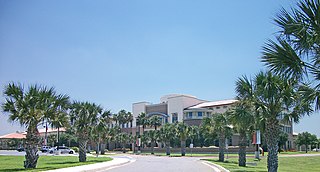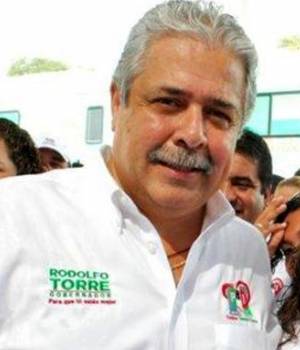
Harlingen is a city in Cameron County in the central region of the Rio Grande Valley of the southern part of the U.S. state of Texas, about 30 miles (48 km) from the coast of the Gulf of Mexico. The city covers more than 40 square miles (104 km2) and is the second-largest city in Cameron County, as well as the fourth-largest in the Rio Grande Valley. As of the 2020 census, the city had a population of 71,892.

Brownsville is a city in the U.S. state of Texas and the seat of Cameron County, located on the western Gulf Coast in South Texas, adjacent to the border with Matamoros, Tamaulipas, Mexico. The city covers 145.2 sq mi (376.066 km2), and had a population of 186,738 at the 2020 census. As of the 2020 U.S. Census, it is the 139th-largest city in the United States and 18th-largest in Texas. It is part of the Matamoros–Brownsville metropolitan area. The city is known for its year-round subtropical climate, deep-water seaport, and Hispanic culture.

Matamoros, officially known as Heroica Matamoros, is a city in the northeastern Mexican state of Tamaulipas, and the municipal seat of the homonymous municipality. It is on the southern bank of the Rio Grande, directly across the border from Brownsville, Texas, United States. Matamoros is the second largest city in the state of Tamaulipas. As of 2016, Matamoros had a population of 520,367. In addition, the Matamoros–Brownsville Metropolitan Area has a population of 1,387,985, making it the 4th largest metropolitan area on the Mexico–US border. Matamoros is the 39th largest city in Mexico and anchors the second largest metropolitan area in Tamaulipas.

The Lower Rio Grande Valley, commonly known as the Rio Grande Valley or locally as the Valley or RGV, is a region spanning the border of Texas and Mexico located in a floodplain of the Rio Grande near its mouth. The region includes the southernmost tip of South Texas and a portion of northern Tamaulipas, Mexico. It consists of the Brownsville, Harlingen, Weslaco, Pharr, McAllen, Edinburg, Mission, San Juan, and Rio Grande City metropolitan areas in the United States and the Matamoros, Río Bravo, and Reynosa metropolitan areas in Mexico. The area is generally bilingual in English and Spanish, with a fair amount of Spanglish due to the region's diverse history and transborder agglomerations. It is home to some of the poorest cities in the nation, as well as many unincorporated, persistent poverty communities called colonias. A large seasonal influx occurs of "winter Texans" — people who come down from the north for the winter and then return north before summer arrives.

The Gulf Cartel is a criminal syndicate and drug trafficking organization in Mexico, and perhaps one of the oldest organized crime groups in the country. It is currently based in Matamoros, Tamaulipas, directly across the U.S. border from Brownsville, Texas.

Charles Stillman was the founder of Brownsville, Texas, and was part owner of a successful river boat company on the Rio Grande.

Sara María Aldrete Villareal is a Mexican serial killer who was convicted of murder while heading a drug-smuggling and human sacrifice cult with Adolfo Constanzo. The members of the cult, dubbed by the media as The Narcosatanists, called her The Godmother, with Constanzo as "The Godfather". The cult was involved in multiple ritualistic killings in Matamoros, Tamaulipas, including the murder of Mark Kilroy, an American student killed in Matamoros in 1989. She received a sentence of 62 years.

The Brownsville & Matamoros International Bridge, also known as B&M International Bridge, Brownsville-Matamoros International Bridge and Express Bridge, is one of three international bridges that cross the U.S.-Mexico border between the cities of Brownsville, Texas, and Matamoros, Tamaulipas. This international bridge unites the Matamoros–Brownsville Metropolitan Area, which counts with a population of 1,136,995, making it the 4th largest metropolitan area in the Mexico-US border.

Bianca Marroquín is a Mexican musical theatre and television actress known for being the first Mexican actress to have a starring role on Broadway. She has performed in the musical Chicago for over twenty years and is one of the few actresses to play both female leads, Roxie Hart and Velma Kelly.

Antonio Ezequiel Cárdenas Guillén, commonly referred to by his alias Tony Tormenta, was a Mexican drug lord and co-leader of the Gulf Cartel, a drug trafficking organization based in Tamaulipas. He headed the criminal group along with Jorge Eduardo Costilla Sánchez. Antonio was considered by Mexican security forces as one of Mexico's most-wanted men.

Rodolfo Torre Cantú was a Mexican physician and politician. He held a number of public offices, such as Federal deputy, Secretary of Health of Tamaulipas and Director-general of the DIF in Ciudad Victoria. While running for governor of Tamaulipas as the candidate of the PRI, he was assassinated, apparently by agents of a drug cartel. Torre was murdered alongside a Tamaulipas lawmaker, Enrique Blackmore, on 28 June 2010 near Ciudad Victoria, which is approximately three hours south of Brownsville, Texas. Felipe Calderón promised a full investigation, saying, "the fight against drug cartels must continue". He further stated, "This was an act not only against a candidate of a political party but against democratic institutions, and it requires a united and firm response from all those who work for democracy." Torre's assassination is the "highest-profile case of political violence" in Mexico since the murder of Luis Donaldo Colosio.

Matamoros–Brownsville, also known as Brownsville–Matamoros, or simply as the Borderplex, is one of the six transborder agglomerations along the Mexico–United States border. It is part of the Lower Rio Grande Valley region. The city of Matamoros is situated in the Mexican state of Tamaulipas, on the south bank of the Rio Grande, while the city of Brownsville is located in the U.S. state of Texas, directly north across the bank of the Rio Grande. The Matamoros–Brownsville area is connected by four international bridges. In addition, this transnational conurbation area has a population of 1,136,995, making it the fourth-largest metropolitan area on the Mexico-U.S. border.

Reynosa–McAllen, also known as McAllen–Reynosa, or simply as Borderplex, is one of the six international conurbations along the Mexico–U.S border. The city of Reynosa is situated in the Mexican state of Tamaulipas, on the southern bank of the Rio Grande, while the city of McAllen is located in the American state of Texas, directly north across the bank of the Rio Grande. This area has a population of roughly 1,500,000, making it the largest and most populous in the state of Tamaulipas, and third most populous on the US–Mexico border.
Charro Days, also known as Charro Days Fiesta or Charro Days Festival, is a two-nation fiesta and an annual four-day pre-Lenten celebration held in Brownsville, Texas, United States in cooperation with Matamoros, Tamaulipas, Mexico. The grito—a joyous Mexican shout—opens the festivities every year. This festival is a shared heritage celebration between the two border cities of Brownsville, Texas and Matamoros, Tamaulipas. The Charro Days festivals usually have about 50,000 attendees each year. This celebration includes the Sombrero Festival as well as a parade that goes down Elizabeth St. through Historic Downtown Brownsville, TX.
The Altamira prison brawl was a deadly fight that occurred on 4 January 2012 in Altamira, Tamaulipas, Mexico. Officials from the state of Tamaulipas confirmed that 31 people were killed, with another thirteen injured. The fight started after a drug gang burst into a section of the prison where they were banned from, attacking their rival gang housed there, triggering the fight. During the altercation, the inmates used several kinds of cold weapons (non-firearms) to kill their opponents. The prisoners also used sticks and knives to massacre the members of the rival gang.

The infighting in the Gulf Cartel refers to a series of confrontations between the Metros and the Rojos, two factions within Gulf Cartel that engaged in a power struggle directly after the death of the drug lord Samuel Flores Borrego in September 2011. The infighting has lasted through 2013, although the Metros have gained the advantage and regained control of the major cities controlled by the cartel when it was essentially one organization.
Saint Joseph's Academy, sometimes referred to as St. Joe or SJA, was a private school started by the Marist Brothers of the Schools. It was located in Laredo, Texas, United States, and served junior high and high school students in Laredo and the surrounding areas.

On March 3, 1993, Saint Joseph Academy high school senior Albert Joseph "Joey" Fischer Jr. was shot dead outside his home in Rancho Viejo, an upscale community north of Brownsville, Texas. Dora Cisneros, the mother of his ex-girlfriend, was responsible for orchestrating Fischer's murder after he broke up with her daughter Cristina. Fischer and Cristina had broken up the previous summer, but Cisneros became obsessed with their relationship and insisted that Fischer date her daughter again. After he refused a US$500 offer from Cisneros, she consulted María Mercedes Martínez, a fortune teller, to cast a spell on him.

Juan Carlos de la Cruz Reyna is a Mexican convicted criminal and former high-ranking member of the Gulf Cartel, a criminal group based in Tamaulipas, Mexico. He was also a senior member in Los Zetas, the Gulf Cartel's former paramilitary group. In the 1990s, de la Cruz Reyna was an officer in the Tamaulipas State Police while working as a hitman for the Gulf Cartel. After he left the agency in 1999, he became a bodyguard for former Gulf Cartel kingpin Osiel Cárdenas Guillén, and was eventually promoted to regional leader of the cartel in Tampico. He reportedly had policemen on his payroll, and managed international drug trafficking shipments from Central and South America.

Líctor Hazael Marroquín García was a Mexican criminal and convicted vehicle thief. He was the best friend of drug kingpin Juan García Abrego, the former leader of the Gulf Cartel, a criminal group based in Tamaulipas, Mexico. In 1978, Marroquín García was indicted by the U.S. District Court of the Southern District of Texas in Brownsville for transporting stolen vehicles from the U.S. into Mexico. He was charged along with seventeen other people, including García Abrego, who was a low-level criminal at that time. Convicted in 1979, Marroquín García had his sentence suspended and was deported back to Mexico. He died of cirrhosis in 1985.

















